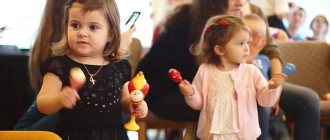When is personality born?
Features of the emotional sphere of a preschooler are manifested in awareness of one’s own personality, activity, activity and objective assessment of oneself. At the same time, a subordination of motives is formed. It indicates that the child is already able to subordinate immediate impulses to more conscious goals.
An indicator of correct development is the ability to manage behavior, control the implementation of assigned tasks and the ability to minimally foresee the result of activity or lack thereof.
What does the correct development of the emotional-volitional sphere of a preschooler lead to? Once uncontrollable emotions and feelings become subordinated to thinking.
The emotional sphere undergoes serious changes with speech and physical development. Outlooks on life and relationships with the outside world are being reformatted globally. What should parents do? They must understand that their child is an individual whose formation takes place with gradual adjustment.
The development of the volitional sphere of a preschooler aged 2-4 years requires a gradual approach. It is important to realize that at this age children often show the full range of negative emotions with loud tantrums, tears and screams.
At the age of 4-5 years, emotions are ruled by the desire for independence, however, difficult situations, fatigue, and emotional overexcitability can lead to the fact that the child’s behavior will exhibit traits that are characteristic of younger peers. The occurrence of such a situation should be a signal to adults: too much has fallen on the child, he cannot bear it. All you need is comfort, affection, care and permission to behave like a little one.
Should a child's bad mood always cause concern for parents? No! A preschooler is subject to feelings; he is unable to correctly and constantly manage his experiences. It is this feature that explains the constant change of mood and a whole range of feelings that arise in a short period of time. Striking laughter can give way to bitter tears and hysterics; such behavior in children is considered absolutely normal.
The development of a stable emotional state directly depends on social situations. Changes in the usual way of life and routine can cause affective reactions and fear. The personality responds to the dissatisfaction of new needs with a state of frustration, which is expressed by rage, aggression and depression.
Main components
The emotional-volitional sphere of a preschooler includes the following elements:
- Emotions. They represent the simplest reactions that appear in a child when he interacts with the world around him. There is a conditional classification of emotions. They are divided into positive (joy and delight), negative (fear, anger), and neutral (surprise).
- Feelings. This component of the sphere under consideration is more complex. It includes various emotions that an individual exhibits in relation to specific events, objects or people.
- Mood. It is a more stable emotional state, depending on many factors. These include: state of health and tone of the nervous system, social environment and activities, family situation, etc. Moods are classified according to their duration. It can be changeable or stable, stable or not. Such factors are determined by a person’s character, his temperament, as well as some other characteristics. Mood has a serious impact on people's activities, stimulating or frustrating them.
- Will. This component reflects a person’s ability to consciously regulate their activities and achieve their goals. It is worth noting that in younger schoolchildren this component is already quite well developed.
Conditions for the successful development of a preschooler
What wrong communication can lead to:
- One-sided attachment to the mother very often results in a limitation of the need to communicate with peers.
- Parents' expression of despair with or without cause creates anxiety and fear in the child.
Irreversible processes in the psyche are triggered by the imposition of parental emotions. In this case, the child does not notice his feelings at all. When they constantly ask whether he likes what, for example, he was praised in class and whether he was offended that his car was taken away, then these events may not at all evoke vivid emotions, but he has to notice them.
Active development of the emotional sphere of a preschooler also occurs during specially organized activities. We are talking about music classes and drawing lessons, during which children learn to experience feelings that arise on the basis of perception.
Intensive development of emotions occurs during play, which is the main activity for preschoolers.
Stages of development
Features of the emotional-volitional sphere in preschoolers of different ages:
- From birth to 1 year. The normal line of development is considered to be recognition of parents, the ability to distinguish close people and respond to their presence, facial expressions, and voice.
- From 1 year to 3 years. During this time period, a minimum level of independence and self-confidence is formed. Correction of the emotional sphere is required if the child doubts his own abilities, there are disturbances in motor skills, and speech is poorly developed.
- From 3 to 5 years. The emotional development of preschool children is manifested in active knowledge of the world around them, vivid imagination, and imitation of the behavior and actions of adults. Additional examinations with corrective classes are carried out if the child experiences constant lethargy, lack of initiative, or depression.
- From 5 to 7 years. At this time, a pronounced sense of duty and desire to achieve a goal arises in the child’s emotional sphere. There is a fairly rapid development of communication and cognitive skills.
Showing feelings
The main changes in the emotional-volitional sphere of a preschooler occur in connection with a change in the hierarchy of motives and the emergence of new needs and interests. In children of this age, there is a gradual loss of impulsiveness of feelings, which become deeper in their semantic content. However, children still cannot fully control their emotions. This is due to organic human needs, such as thirst, hunger, etc.
In addition, the role of emotions in the activities of a preschooler is also subject to change. And if at earlier stages of ontogenesis the main guideline for a little person was the assessment of adults, now he is able to experience joy based on his own anticipation of a positive result and the good mood of those around him.
Gradually, the preschooler masters the expression of emotions in their expressive forms. That is, facial expressions and intonations become available to him. Mastering such expressive means allows the child to deeply understand the experiences of other people.
When studying the emotional-volitional sphere of a preschooler, it becomes clear that speech has an important influence on its development. At the same time, there is an intellectualization of processes associated with knowledge of the surrounding world.
At about 4-5 years old, children begin to develop a sense of duty. The basis of its formation is the child’s moral awareness of the requirements that are presented to him as an individual. This leads to the fact that preschoolers begin to correlate their actions with similar actions of surrounding adults and peers. The sense of duty is most clearly demonstrated by children aged 6-7 years.
Thanks to the intensive development of curiosity, preschoolers more often begin to show surprise and joy in learning new things. Aesthetic feelings also receive further development. This happens thanks to the child’s activities in the creative and artistic direction.
Ways to develop emotional-volitional qualities
To develop the emotional sphere, two techniques are actively used: sand therapy and fairy tale therapy.
The second method has its roots in the 17th century, but before the research of V. Propp and R. Gardner, fairy tales were just fun. With the help of fairy tales, personality integration, expansion of consciousness, development of creative abilities are carried out, and lines of interaction with the outside world are formed.
A correctly chosen fairy tale can cause intense emotional resonance and appeal not only to the child’s consciousness, but also to his subconscious. The method acquires particular relevance when working with children with deviations in the emotional sphere, when it is necessary to create an effective communication situation.
A fairy tale performs several functions:
- psychologically prepares the child for difficult situations;
- allows you to try on different roles, evaluate actions and results of activities;
- draw conclusions and transfer them to real life.
Working methods:
- Fairy tale-metaphor. The images and plots of fairy tales stimulate free associations in the mind, which in the future should be actively discussed and corrected by the teacher.
- An equally active method is drawing based on fairy tales. In this case, associations are expressed in graphic form rather than verbal.
- A fairy tale forms the concept of what is good and bad. Based on the actions and actions of the characters, the child can make his motivated verdict on the behavioral line.
- The emotions evoked by a fairy tale can not only be spoken or drawn, but also played out using facial expressions and intonation.
- Maximum creativity allows you to rewrite, add to the fairy tale, change its ending, and add new heroes and characters.
Fairy tales are notable for the fact that they lack direct edifications and moral teachings; events are always logical and dictated by the cause-and-effect relationships that exist in the world.
The emotional development of preschool children is also effectively achieved with the help of sand therapy. K. D. Ushinsky argued that the best toy for a child is a pile of sand. And so it is. Playing with sand is known to every generation. Sand play is simple, accessible, convenient and varied.
The main advantage of sand is that it allows the child to build his own individual world, imagining himself as a creator who sets the rules of the game. Simply pouring sand helps relieve tension and calm down; sculpting figures develops fine motor skills and stimulates imagination; searching for buried treasures stimulates interest.
Educational games with sand help identify psychological trauma and allow you to get rid of them. This method is especially effective when working with children who have verbal deficits and developmental delays.
Empathy in children
The most important component of the emotional development of a preschool child is the development of empathy, namely the ability to sympathize and understand the experiences and emotions of other people. A child who has developed empathy will always put himself in the position of this or that person and offer him his help.
"This is interesting. The author of the theory of emotional intelligence, Daniel Goleman, is convinced that success in life depends not only on the level of intelligence, but also on a good ability to manage one’s own emotions. And by understanding one’s own emotions, a person will feel and be aware of the emotions of others.”
Forming empathy in a preschooler is the key to successful schooling, easy socialization, and problem-free communication. If only for this reason, parents should definitely pay attention to the development of empathy along with the development of the child’s intellectual, communication, cognitive, creative and other abilities.
Tips for developing empathy:
- Create a warm atmosphere in the family where love and mutual understanding will reign.
- Discuss different life situations with your child.
- Introduce your child to the principles of existence in society.
- Explain how to properly deal with people in different situations.
- Explain what consequences this or that behavior of people may have.
- Develop positive social character traits in your child: optimism, trust, forgiveness, solidarity.
- Teach your child to do useful things and help others. Don't forget about praise.
- Empathize with the child, communicate with him about how he feels.
- Develop your child emotionally: discuss thematic images and photographs, depict emotions in front of the mirror, play emotional games.
- Be a role model for your child: adhere to the same principles that you teach your child.
Working on EQ
EQ is an international abbreviation for emotional intelligence. This term refers to the child’s ability to recognize his emotions and associate them with desires and actions. With low EQ scores, contradictory behavior, insufficient contact with peers, inability to express one's needs, aggressiveness and fear are observed.
Effective games for the development of emotional (communicative) intelligence:
- "Satisfied elephant." To play the game you will need pictures of animal faces. The presenter holds up a card with an emotion diagram and asks you to find a picture of an animal that experiences the same feeling.
- "Pictograms". It is necessary to prepare two sets of cards in advance (cut and whole). The cut pictograms are mixed in the total mass, the child’s goal is to assemble the whole template.
The second option involves doubles play. One of the children chooses half of the picture and describes it to his interlocutor, the goal is to find the second half of the picture. If there is a discrepancy, you must provide an explanation of why this particular picture was chosen.
- "How are you?". The simplest game that allows you to determine the mood and emotions of children with affective behavior. You need to invite the child from a stack of cards depicting emotions to choose the one that matches his mood (now, an hour ago, yesterday).
- "Broken phone". An original game to develop emotional intelligence that can be played with children over 3 years old. The entire “telephone network” closes its eyes, only the first link remains awake. The presenter shows him the emotion and offers to pass it on to the next person. Transmission is carried out only by facial expressions and gestures. After the action reaches the last player, the presenter, starting from the end, asks what emotion was conveyed and why, whether it was difficult to understand the participant.
The emotional sphere is an important component in the development of preschoolers, since no communication or interaction will be effective if its participants are not able, firstly, to “read” the emotional state of another, and secondly, to manage their emotions. Understanding your emotions and feelings is also an important point in developing the personality of a growing person.
Throughout preschool childhood, the “education of feelings” occurs - over time, they become deeper, more stable, and more intelligent.
The strongest and most important source of a child’s experiences is his relationships with other people, adults and children. When others treat a child kindly, recognize his rights, and show him attention, he experiences emotional well-being—a feeling of confidence and security. Usually, under these conditions, the child is in a cheerful, cheerful mood. Emotional well-being contributes to the normal development of a child’s personality, the development of positive qualities, and a friendly attitude towards other people. Emotional well-being also provides high self-esteem, formed self-control, orientation towards success in achieving goals, emotional comfort in the family and outside the family. It is emotional well-being that is the most capacious concept for determining the success of a child’s development.
In preschool age, that relatively stable inner world is formed, which gives grounds for the first time to call a child a personality, although, of course, a personality that is not yet fully formed, but capable of further development and improvement.
The main way adults influence the development of children’s personality is through organizing the assimilation of moral norms that regulate the behavior of people in society. These norms are acquired by the child under the influence of models and rules of behavior. Models of behavior for children are, first of all, adults themselves: their actions, relationships. At the same time, of course, the most important component of an adult’s influence on a child is his, the adult’s, own system of emotional reactions, assessments, and characteristics.
The behavior of the people immediately around him has the most significant impact on the child. He is inclined to imitate them, adopt their manners, borrow from them their assessment of people, events, and things. However, the matter is not limited to loved ones. A preschool child gets acquainted with the life of adults in many ways: by observing their work, listening to stories, poems, and fairy tales. The model for him is the behavior of those people who evoke the love, respect and approval of others. The behavior of peers who are approved and popular in the children's group can also serve as a model for the child. Finally, the patterns of behavior presented in the actions of fairy-tale characters endowed with certain moral traits are of considerable importance.
If an adult is friendly to the child, rejoices with him in his successes and empathizes with his failures, then the child retains good emotional well-being, a readiness to act and overcome obstacles even in the event of failure. When a positive relationship is established with an adult, the child trusts him and easily comes into contact with others.
In our kindergarten, every year a diagnosis of the emotionally-volitional sphere of personality and the emotional state of the child in the kindergarten group is carried out. I would like to note that most children have recently, compared to previous years, experienced a decrease in the level of development of the emotional sphere, an increasing number of children are experiencing difficulties in communicating with peers, awareness of their emotions and control over them are reduced. Frequent conflicts arise between children, which they do not know how to resolve. Unfortunately, we have to note that children become less responsive to the feelings of other people.
At all stages of a preschooler’s physical development, it is necessary to expand knowledge about emotional phenomena, the emotional sphere of a person and one’s own emotional manifestations. By explaining what emotions are, how they are expressed and what the consequences of emotions are, we form a vocabulary of emotions, activate ways and means of identifying emotions, thereby facilitating the child’s communication with the outside world, developing his cognitive potential and forming the foundations of morality. For example, in a role-playing game, a child accepts a situation “as if” and at the same time, without changing himself, maintaining contact with reality, experiences real emotions in accordance with the plot.
It is also necessary to enrich the positive emotional experience of children, and through replaying emotional experiences, relieve tension, anger and develop independent skills in dealing with negative emotions.
An important part of enriching the emotional sphere of a preschooler is also the expansion of the means of expressing emotional states and the formation of skills for voluntary expression of emotions. By conducting creative games such as “Complete the face” or “Find differences in facial expressions”, discussing facial signs, the teacher helps the child with solving this issue.
The proactive initiative of an adult is the main feature in correcting the child’s sphere of communication and expanding his emotional sphere.
Parents and educators of preschool children should pay great attention to role-playing games, acting out various scenes with emotional overtones, it is necessary to attend theatrical productions, circus performances, look at paintings and listen to musical compositions with different emotional overtones.
Psychogymnastics should be used in work. Psychogymnastics is a course of special classes (studies, exercises and games) aimed at developing and correcting various aspects of the child’s psyche (both its cognitive and emotional-personal spheres).
It is also necessary to note games for the development of emotional expression, or emotionally expressive games. They are aimed at developing facial, pantomimic, speech motor skills, gestural expressiveness - in other words, the “language” of emotions, which create a favorable background for the manifestation of individuality, the development of emotional sensitivity, etc. They are used in joint activities, starting from the middle group; By the age of four, children have developed a certain emotional and sensory experience, and they are able to act from a certain person, orient themselves to the attitudes of an adult, etc.
When working with children, it is advisable to use the works of children's writers and poets, folklore. They are a special form of understanding the surrounding reality, forming an emotional attitude towards the world. Fairy tales, short stories, nursery rhymes, etc. enrich the vocabulary of emotional vocabulary, develop an imaginative worldview, responsiveness, and serve as an excellent occasion for a meaningful dialogue between the teacher and children.
Objectives and options for practical activities for each age group.
Second junior group.
The main tasks at this age stage are:
— Encouraging children to react emotionally through the targeted supply of sensory information through the channels of the visual, auditory, vestibular, olfactory, tactile and taste analyzers;
— Maintaining the expressive manifestations of children (facial expressions, gestures, speech) in the process of interaction with sensory stimuli that differ in modality, intensity, and duration.
To implement these tasks, we can recommend the following sensory games.
"Travelers"
The teacher suggests walking barefoot on different surfaces (soft, smooth, ribbed, etc.).
Games with water - launch boats, bathe toys, fill plastic containers, rubber toys (pears) with water and pour it out, plunge plastic balls and toys to the bottom.
“It’s raining” (pouring water from a watering can into basins).
“Who can hold the water longer” (they collect water in their palms, trying to hold it for as long as possible).
“The sea is agitated” (hands depict sea waves).
"Breeze"
The teacher holds in his hand a plume to which light ribbons are attached, and says the following words:
Wind, blow stronger
Unfurl the ribbons quickly.
Wey, wey, breeze,
Get him, buddy!
Then he begins to move quickly, waving his plume. Children try to catch the “breeze”.
In parallel with sensory games, it is recommended to conduct games aimed at developing the mechanisms of emotional expression, primarily gestural expressiveness.
The plot basis of such games can be the works of children's writers, poets, and folklore.
"Bear Cubs"
The teacher reads P. Voronko’s poems, inviting the children to move.
The cubs lived in the thicket, turning their heads. Like this! (They shift from foot to foot, turn their head.)
The cubs were looking for honey and shook the bush together. Like this! (Imitate the swaying of bushes.)
They waddled and drank water from the river. Like this! (They waddle, awkwardly, then bend down, “drink water.”)
And then they danced, raising their paws higher. (They dance, raising their knees high.)
In the second younger group, it is also necessary to introduce children to vocabulary that reflects the most vivid, visually easily identifiable emotional states: joy (joyful, joyful), sadness (sad, sad), fun (cheerful, cheerful, etc.), sadness (sad , sad, etc.), fright (scared, scared), anger (angry, angry), etc.
The main role in solving this problem is played by literature and folklore. When reading fairy tales, short stories, etc., the teacher focuses children’s attention on words that characterize certain emotional states. At the same time, you can demonstrate the manifestation of emotions in gestures, facial expressions, intonation, and encourage children to identify emotional states using questions: “Why did the bear run away when he heard the fox’s song?”, “Do you think the goat has always been cheerful? What else was she like?” etc.
Children of this age must also learn to see and reproduce the characteristic features of the design of emotional states (joy, sadness, fear, anger). For this, it is appropriate to use illustrative material, theatrical activities, etc. For example, using a series of story pictures and sets of cards depicting the main character in different emotional states, the teacher invites children to choose a card for each story picture that matches the hero’s mood.
Middle group.
At this age stage, it is necessary to solve many more problems related to the emotional development of children. This is primarily an expansion of the experience of emotional response through the introduction of various sensory stimuli, often complex (visual - vestibular, visual - auditory - tactile, etc.)
For the development of emotional expression, its mechanisms: non-verbal (facial, pantomimic, gestural) and verbal (words, sounds, phrases), as well as the formation of the foundations of expressiveness of external emotional manifestations, it is advisable to use emotionally expressive games (children embodying various situations from the life of animals, their habits; conveying the emotional states of fairy-tale characters through personification, etc.). Taking into account the age characteristics of children, the emotional-game context is specific, prompting and guiding.
In middle preschool age, it is also important to replenish the “emotional” vocabulary with words denoting various moods, states (surprised, surprised, scary, scared, angry, angry, grief, grieving, cowardly, offended, sad, mischievous, etc.); phrases that reflect shades of mood (not very angry, not at all scary, very sad, etc.); learn to select synonyms (joyful - cheerful, sad - sad, sad); find words that specify emotional states: angry (unpleasant, rude, angry); cheerful (happy, laughing); understand emotional characteristics presented in the form of phraseological units: Masha is confused, the girl is picky, good doctor Aibolit, etc.
To make it easier for children to master an emotional vocabulary and develop the ability to analyze emotions using words, they should first turn to fiction. It is also advisable to use visual models - a series of paintings reflecting episodes of fairy tales and stories. By showing this or that image, the teacher suggests remembering the hero’s mood and giving him a generalized emotional description.
You can make a cardboard circle with a moving arrow and depicting animals and people in different emotional states. Pointing to one of them, the teacher asks the children to name this mood, choose words - synonyms (sad hare, what else?).
To continue a meaningful dialogue with children, turning to other types of activities will allow you to turn to other types of activities: visual (the teacher, together with the children, draws Masha the Confused Man, the good Doctor Aibolit, etc.), musical (selecting musical accompaniment for fairy tales).
It is advisable to teach children to identify and differentiate emotional states (joy, sadness, fear, surprise, anger) based on external signs, and to notice changes (transitions) in mood.
To solve these problems, you can conduct conversations using pictograms, games, for example, “Confusion.”
The teacher places in front of the children a large sheet of thick paper on which people, animals, various objects, natural phenomena, etc. are drawn, connected to each other by winding lines of various colors. Offers to figure out who (or what?) the puppy, mouse, bird, etc. are afraid of; who (or what) upset the girl; who (or what) amused the boy, etc. Then, he offers his options for correcting negative experiences. For example, how to calm a puppy, how to help a girl overcome sadness, etc.
It is advisable to introduce children to the “Book of Moods”. It is created by the teacher. To do this, you need to bend five to six landscape sheets in half and fasten them in the middle. Even-numbered pages represent symbolic images of various moods (pictograms), and odd-numbered ones reflect life situations, episodes of fairy tales, cartoons, objects, phenomena that can cause a particular emotional state. When considering the “Book of Moods,” it is advisable to encourage children to supplement its content with their own life experiences (name what (who) brings you joy; what can make you sad, what it means to be offended, etc.).
You can complete tasks in the “Rainbow of Moods” albums, which require conveying emotions with color. For example:
· The teacher depicts the girls’ faces in a state of joy and sadness, asks them to draw a dress, bows, shoes that suit each of them.
· The teacher draws pictograms and several circles around them. Invites children to depict in circles objects, events, etc. that can evoke a particular mood.
· Depicts episodes from fairy tales (cheerful and sad animals around Aibolit, guests at Soroka’s name day - white-sided, etc.), offering to color each character according to his emotional state.
Senior preschool age.
The tasks of this age period include the following:
· Improving the experience of external expression of emotions, encouraging the transfer of subtle shades of mood, demonstrating the diversity of components of emotional expression: facial expression, pantomimic, gestural, speech;
· Stimulating the manifestation of an individually unique style of play behavior, originality of emotional response.
To achieve these goals, it is recommended to conduct a series of emotionally expressive games. Here are some of them.
Older children continue to be taught to understand, differentiate the emotional state based on external signs (facial expressions, gestures, postures, voice intonations), determine the reasons for a particular mood by analyzing circumstances, events, etc.; They develop the ability to respond to the emotional state of another person, to show empathy, joy, and action.
In the implementation of these tasks, fiction, especially landscape poetry, provides great assistance, where various moods and connections between human experiences and the state of nature are conveyed. An important place is given to conversations and games.
Using problematic situations and visual material, you can dwell on such points as the reasons that cause certain emotional experiences, ways to change negative experiences.
In the future, it is recommended to bring children to the idea: a person’s mood largely determines his view of the world around him, relationships between people, etc.
In the course of joint activities, work continues to enrich the vocabulary of emotional vocabulary (indifferent, pathetic, greedy, capricious, lazy, offended, ashamed, boring, tired, etc.), while it is important to encourage children not only to name emotional states, but also to select synonyms, highlight shades of mood, trace associative connections with color. While reading excerpts from works of fiction, the teacher suggests characterizing the features of the external expression of a particular state (for example, what does tired mean); reproduce this state with movements, choose a color that matches it.
In communication, it is important to pay attention to the figurativeness of the stylistic forms of children’s speech.
Children continue to be taught to understand emotional characteristics in the form of phraseological units and to use them adequately (Tsarevna - Nesmeyana, Vovka - a kind soul, The Ugly Duckling, etc.). To do this, it is necessary to introduce children to works containing such collective images: A. Barto (“Vovka is a kind soul”, “Girl is a roarer”), G. H. Andersen (“The Ugly Duckling”, “Thumbelina”), The Brothers Grimm ( “Cinderella”), S. Marshak (“He’s so absent-minded”), Y. Akim (“Neumeika”), S. Mikhalkov (“Foma”), the fairy tale “Kroshechka - Khavroshechka”, etc.
You can create an album “They live among us” (each drawing is thoroughly thought out together with the children: background, pose, facial expression, surrounding objects, etc.).
It is recommended to hold conversations and evenings of entertainment, for example, “Journey to the Land of Familiar Heroes.” The teacher prepares in advance silhouette images of the Princess - Nesmeyana, the Ugly Duckling, the Scattered One from Basseynaya Street, etc. Offers to go to an amazing country, where they will meet interesting characters.
Thus, the emotional development of preschool children is one of the most important areas of professional activity of preschool teachers.
Games for the development of the emotional sphere
By being included in the game, children gain invaluable experience in simulating life situations. A list of the most interesting and universal games is proposed that contribute to the formation and development of the emotional and volitional sphere of preschool children.
"Guess the Emotion"
The main activity in the game is aimed at actively studying gestures and facial expressions that arise when a particular emotion is manifested. Thanks to her, the child learns to recognize the feelings and moods of others.
For the game you will need masks depicting various emotions. At the age of 5-6 years, children can already take part in production. It is imperative to portray delight, sadness, surprise, joy, indifference, fear.
One of the children is put on a mask (unknown to him), his task is to determine the emotion based on the group’s clues. As clues, you can use a visual description (position of lips, eyebrows) and situational (an emotion occurs when...).
"Mimic exercise"
Improves the ability to correctly express emotions and do this in conjunction with verbal and non-verbal manifestations, and also activates the development of emotional intelligence in preschool children.
You should write or depict emotions on the cards (depending on the age of the children) and ask the child to show them in conjunction with a fairy-tale hero: smile like Cinderella; be surprised how Pinocchio...
"Actor"
A game aimed at developing the ability to distinguish the psychological state of people, guided by non-verbal manifestations.
The child’s task is to depict the necessary emotion using gestures and facial expressions. In this case, part of his face is covered with a mask or a sheet of paper. The team's task is to guess the depicted emotion.
"There is a team!"
The game is aimed at developing the ability to quickly concentrate. Children marching to the music are given commands in a whisper (sit down, raise their hands, grab their shoulders). Note: Only calm movements are selected for the game.
The development of the emotional sphere in preschool children is a long and multifaceted process that requires comprehensive development and coordinated action of all participants (teachers, educators, psychologists, parents). Only with this approach is the emotional well-being of preschoolers achieved, allowing the formation of a successful personality.
Motives for activity
In preschool age, the identification of what determines the child’s behavior occurs. This is the leading motive that subordinates all others. This happens when communicating with adults. As a result of the emerging social situation, certain actions of the child acquire a rather complex meaning.
From about three years of age, children's behavior is increasingly subject to the influence of motives. They are reinforced, come into conflict or replace each other. After this age, intensive formation of voluntary movements occurs. And mastering them perfectly becomes the main goal of a preschooler’s activity. Gradually the movements begin to become manageable. The child begins to control them thanks to the sensorimotor image.
At 3-4 years old, children increasingly begin to use games to solve cognitive problems. They have a significant impact on the development of the emotional-volitional sphere of preschoolers. The most effective incentives for this are the motives of recovery and reward. At the age of 4, children begin to identify the object of their activity and realize the purpose of transforming a specific object. At the age of 4-5, a significant part of preschoolers become characterized by moral motives. Children control their own behavior through vision control.
At 5-6 years old, preschoolers acquire some techniques that allow them not to be distracted. By the age of five, children begin to realize that various components of activity are mutually dependent.
Upon reaching the age of six, the child’s activities become generalized. He develops voluntary actions, which can be judged by the initiative and activity of the preschooler.
By the age of 6-7, children are already more adequate in their attitude towards their achievements. At the same time, they see and evaluate the successes of their peers.
In older preschoolers, voluntariness begins to be observed in mental processes. This concerns their internal mental characteristics such as thinking and memory, imagination, speech and perception.






